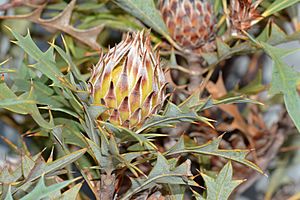Yilgarn dryandra facts for kids
Quick facts for kids Yilgarn dryandra |
|
|---|---|
 |
|
| Conservation status | |
| Scientific classification | |
| Genus: |
Banksia
|
| Species: |
arborea
|
| Synonyms | |
|
Dryandra arborea C.A.Gardner |
|
The Yilgarn dryandra (scientific name: Banksia arborea) is a special tree found only in Western Australia. It has pointy leaves with jagged edges and bright yellow flowers. You can find it growing in the dry inland areas, north of a town called Southern Cross.
Contents
Discover the Yilgarn Dryandra Tree
The Yilgarn dryandra is a type of tree that can grow up to 6 meters (about 20 feet) tall. It has a thick trunk that helps it stand strong. Its leaves are shaped like a spear or an oval. They are about 30 to 60 millimeters long and 14 to 22 millimeters wide. Each leaf has up to six sharp, triangular teeth on its sides, making them look serrated.
Flowers and Fruit of the Yilgarn Dryandra
This tree produces flower spikes at the ends of its branches. Each spike is made up of 110 to 180 individual flowers! These flowers are yellow and have a shaggy, hairy look. They are about 20 to 28 millimeters long. The Yilgarn dryandra usually blooms between March and May, or sometimes in September or October. After flowering, the tree grows egg-shaped fruits called follicles. These fruits are 8 to 15 millimeters long and open up when they are ready.
Naming the Yilgarn Dryandra
The Yilgarn dryandra was first officially described in 1964. A botanist named Charles Gardner gave it the name Dryandra arborea. He wrote about it in the Journal of the Royal Society of Western Australia. Gardner found specimens of this tree on hills near Koolyanobbing.
Changing the Scientific Name
Later, in 2007, two other scientists, Austin Mast and Kevin Thiele, changed its name to Banksia arborea. The word arborea in its scientific name comes from Latin. It means "tree-like," which perfectly describes this plant.
Where the Yilgarn Dryandra Lives
The Yilgarn dryandra grows in a specific type of environment. It likes to grow among ironstone rocks in open shrubland areas. These areas are usually found on hills north of Southern Cross in Western Australia.
Protecting the Yilgarn Dryandra
The Government of Western Australia's Department of Parks and Wildlife has classified this banksia as "Priority Four." This means it is a rare plant or one that is almost threatened. It needs special attention to make sure it continues to grow and thrive.
Future Challenges for the Yilgarn Dryandra
Scientists have studied how climate change might affect this tree. They found that the area where the Yilgarn dryandra can grow might shrink a lot by the year 2080. Depending on how much the climate changes, its habitat could become 50% to 80% smaller. This makes protecting this unique tree even more important.


